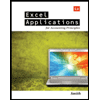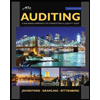
a
Introduction: When the intercompany transfer of asset occurs, the parent company must make adjustments in preparing consolidated financial statements as long as the asset is held by the acquiring company, when the asset is transferred at book value no special adjustments are needed. But when the asset is transferred at more or less than the book value, the unrealized gain or loss is deferred until the asset is sold to an unrelated party. Moreover in the consolidation, the gain or loss will be eliminated.
The adjustments in
a
Answer to Problem 7.41AP
The amount of differential as of January 1, 20X8 $120,000
Explanation of Solution
| Debit $ | credit $ | |
| Income from S company | 2,000 | |
| Investment in S company | 38,400 | |
| | 40,400 |
| Particulars | P company | L company | ||
| Debit $ | credit $ | Debit $ | credit $ | |
| Cash and accounts receivables | 151,000 | 55,000 | ||
| Inventory | 240,000 | 100,000 | ||
| Land | 100,000 | 80,000 | ||
| Buildings and equipment | 500,000 | 150,000 | ||
| Investment in L company | 240,000 | |||
| Cost of goods sold | 160,000 | 80,000 | ||
| 25,000 | 15,000 | |||
| Other expenses | 20,000 | 10,000 | ||
| Dividends declared | 60,000 | 35,000 | ||
| 230,000 | 60,000 | |||
| Accounts payable | 60,000 | 25,000 | ||
| Bonds payable | 200,000 | 50,000 | ||
| Common stock | 300,000 | 100,000 | ||
| Retained earnings | 420,000 | 140,000 | ||
| Sales | 250,000 | 150,000 | ||
| Income from subsidiary | 36,000 | |||
| Total | 1,496,000 | 1,496,000 | 525,000 | 525,000 |
b
Introduction: When the intercompany transfer of asset occurs, the parent company must make adjustments in preparing consolidated financial statements as long as the asset is held by the acquiring company, when the asset is transferred at book value no special adjustments are needed. But when the asset is transferred at more or less than the book value, the unrealized gain or loss is deferred until the asset is sold to an unrelated party. Moreover in the consolidation, the gain or loss will be eliminated.
The entries that would have been recorded on P’s books during 20X7 if it had always used the modified equity method.
b
Explanation of Solution
| Particulars | Debit $ | Credit $ |
| To record share in S company income: | ||
| Investment in S company | 36,000 | |
| Income from S company | 36,000 | |
| (Investment in S company recognized) | ||
| To record receipt of dividends from L: | ||
| Cash | 28,000 | |
| Investment in S company | 28,000 | |
| (Received cash dividends from L) |
- Income from subsidiary recognized and credited to income from subsidiary and debited to investment account
- Cash dividends received from subsidiary credited to investment account
c
Introduction: When the intercompany transfer of asset occurs, the parent company must make adjustments in preparing consolidated financial statements as long as the asset is held by the acquiring company, when the asset is transferred at book value no special adjustments are needed. But when the asset is transferred at more or less than the book value, the unrealized gain or loss is deferred until the asset is sold to an unrelated party. Moreover in the consolidation, the gain or loss will be eliminated.
The consolidation entries required to prepare a three-part consolidated worksheet at December 31, 20X7
c
Explanation of Solution
| Particulars | Debit $ | Credit $ |
| 1. Elimination of beginning investment | ||
| Common stock | 100,000 | |
| Retained earnings | 140,000 | |
| Income from L | 36,000 | |
| Non-controlling interest in net income of L | 9,000 | |
| Dividends declared | 35,000 | |
| Investment in L | 200,000 | |
| Non-controlling interest in net assets of L | 50,000 | |
| (Beginning investment in S eliminated by reversal) | ||
| 2. Excess value of differential reclassification | ||
| Retained earnings | 14,400 | |
| 32,000 | ||
| Investment in L | 40,000 | |
| Non-controlling interest in net assets of L | 6,400 | |
| (Recognition of differential on land and goodwill) | ||
| 3. Elimination of intercompany receivables and payables | ||
| Accounts payable | 4,000 | |
| Cash and | 4,000 | |
| (Intercompany other receivables and payables eliminated by setoff) | ||
| 4. Elimination of gain on purchase of land | ||
| Retained earnings | 8,000 | |
| Non-controlling interest in net income of L | 2,000 | |
| Land | 10,000 | |
| (Gain on purchase of land eliminated) | ||
| 5. Elimination of gain on equipment asset basis | ||
| Retained earnings | 18,000 | |
| Equipment | 5,000 | |
| Accumulated depreciation | 23,000 | |
| (Gain on equipment recognized) | ||
| 6. Excess depreciation recognized | ||
| Accumulated depreciation | 2,000 | |
| Depreciation expenses | 2,000 | |
| (Excess depreciation recognized) |
- Elimination of beginning investment
- Differential on goodwill and retained earnings recognized
- Intercompany receivable and payable eliminated by setoff
- Gain on purchase of investment eliminated by reversal
- Gain on sale of equipment is eliminated by crediting and depreciation recognized
d
Introduction: When the intercompany transfer of asset occurs, the parent company must make adjustments in preparing consolidated financial statements as long as the asset is held by the acquiring company, when the asset is transferred at book value no special adjustments are needed. But when the asset is transferred at more or less than the book value, the unrealized gain or loss is deferred until the asset is sold to an unrelated party. Moreover in the consolidation, the gain or loss will be eliminated.
The three part consolidation worksheet for December 31, 20X7.
d
Answer to Problem 7.41AP
Balance as per three part consolidated work sheet:
- Retained earnings $402,600
- Net assets $1,088,000
Explanation of Solution
| Elimination | |||||
| Items | P $ | S $ | Debit $ | Credit $ | Consolidation $ |
| Sales | 250,000 | 150,000 | 400,000 | ||
| Less: | |||||
| Cost of goods sold | (160,000) | (80,000) | (240,000) | ||
| Depreciation expenses | (25,000) | (15,000) | 2,000 | (38,000) | |
| Other expenses | (20,000) | (10,000) | (30,000) | ||
| Income from S Corp | 36,000 | 36,000 | |||
| Consolidated net income | 92,000 | ||||
| Non-controlling interest | 9,000 | (9,000) | |||
| Net income carry forward | 81,000 | 45,000 | 45,000 | 2,000 | 83,000 |
| Retained earnings | 42,000 | 140,000 | 140,000 | ||
| 14,400 | |||||
| 8,000 | |||||
| 18,000 | 379,600 | ||||
| Net income | 81,000 | 45,000 | 45,000 | 2,000 | 83,000 |
| Less: Dividends declared | (60,000) | (35,000) | 35,000 | (60,000) | |
| Retained earnings Dec 31 | 441,000 | 150,000 | 225,400 | 37,000 | 402,600 |
| Cash and receivables | 151,000 | 55,000 | 4,000 | 202,000 | |
| Inventory | 240,000 | 100,000 | 340,000 | ||
| Land | 100,000 | 80,000 | 10,000 | 170,000 | |
| Buildings & equipment | 500,000 | 150,000 | 5,000 | 655,000 | |
| Less: Accumulated depreciation | (230,000) | (60,000) | 2,000 | 23,000 | (311,000) |
| Investment in L | 240,000 | 200,000 | |||
| 40,000 | |||||
| Goodwill | 32,000 | 32,000 | |||
| Total Assets | 1,001,000 | 325,000 | 39,000 | 277,000 | 1,088,000 |
| Accounts payable | 60,000 | 25,000 | 4,000 | 81,000 | |
| Bonds payable | 200,000 | 50,000 | 250,000 | ||
| Common stock | 300,000 | 100,000 | 100,000 | 300,000 | |
| Retained earnings | 441,000 | 150,000 | 225,400 | 37,000 | 402,600 |
| Non-controlling interest in net assets of S | 2,000 | 50,000 | 54,400 | ||
| 6,400 | |||||
| Total Liabilities & Equity | 1,001,000 | 325,000 | 331,400 | 93,400 | 1,088,000 |
Want to see more full solutions like this?
Chapter 7 Solutions
ADVANCED FINANCIAL ACCOUNTING IA
- Montu Consultants Corporation obtained a building, its surrounding land, and a computer system in a lump-sum purchase for $375,000. An appraisal set the value of the land at $184,500, the building at $144,000, and the computer system at $121,500. At what amount should Montu Consultants record each new asset on its books?arrow_forwardPlease provide the solution to this financial accounting question with accurate financial calculations.arrow_forwardCan you solve this general accounting problem using accurate calculation methods?arrow_forward
- Question: The balanced scorecard approach includes a) Only financial measures b) Only non-financial measures c) Both financial and non-financial measures d) Only customer measuresarrow_forwardAccurate answerarrow_forwardCan you solve this general accounting question with accurate accounting calculations?arrow_forward
- What is the difference between actual and budgeted costs?arrow_forwardHow much is samantha's disposable income ?arrow_forwardArdor Ltd. purchased a new equipment that is expected to be used in operations for 6 years for $60,000. The salvage value of the equipment after 6 years is $6,000. Assume the equipment was purchased on the first day of the fiscal year so no partial-year depreciation is needed. Using the Straight-Line Depreciation Method, what is the value of accumulated depreciation at the end of year 4?arrow_forward
- What is florence corp.'s net income for the year ?arrow_forwardThe beginning inventory of finished goods must have been?arrow_forwardMichiko Industries uses flexible budgets. At a normal capacity of 25,000 units, the budgeted manufacturing overhead is $75,000 variable and $300,000 fixed. If Michiko Industries had actual overhead costs of $385,500 for 27,000 units produced, what is the difference between actual and budgeted costs?arrow_forward
 Financial Reporting, Financial Statement Analysis...FinanceISBN:9781285190907Author:James M. Wahlen, Stephen P. Baginski, Mark BradshawPublisher:Cengage Learning
Financial Reporting, Financial Statement Analysis...FinanceISBN:9781285190907Author:James M. Wahlen, Stephen P. Baginski, Mark BradshawPublisher:Cengage Learning Excel Applications for Accounting PrinciplesAccountingISBN:9781111581565Author:Gaylord N. SmithPublisher:Cengage Learning
Excel Applications for Accounting PrinciplesAccountingISBN:9781111581565Author:Gaylord N. SmithPublisher:Cengage Learning Financial AccountingAccountingISBN:9781337272124Author:Carl Warren, James M. Reeve, Jonathan DuchacPublisher:Cengage Learning
Financial AccountingAccountingISBN:9781337272124Author:Carl Warren, James M. Reeve, Jonathan DuchacPublisher:Cengage Learning Intermediate Accounting: Reporting And AnalysisAccountingISBN:9781337788281Author:James M. Wahlen, Jefferson P. Jones, Donald PagachPublisher:Cengage Learning
Intermediate Accounting: Reporting And AnalysisAccountingISBN:9781337788281Author:James M. Wahlen, Jefferson P. Jones, Donald PagachPublisher:Cengage Learning Auditing: A Risk Based-Approach to Conducting a Q...AccountingISBN:9781305080577Author:Karla M Johnstone, Audrey A. Gramling, Larry E. RittenbergPublisher:South-Western College Pub
Auditing: A Risk Based-Approach to Conducting a Q...AccountingISBN:9781305080577Author:Karla M Johnstone, Audrey A. Gramling, Larry E. RittenbergPublisher:South-Western College Pub





